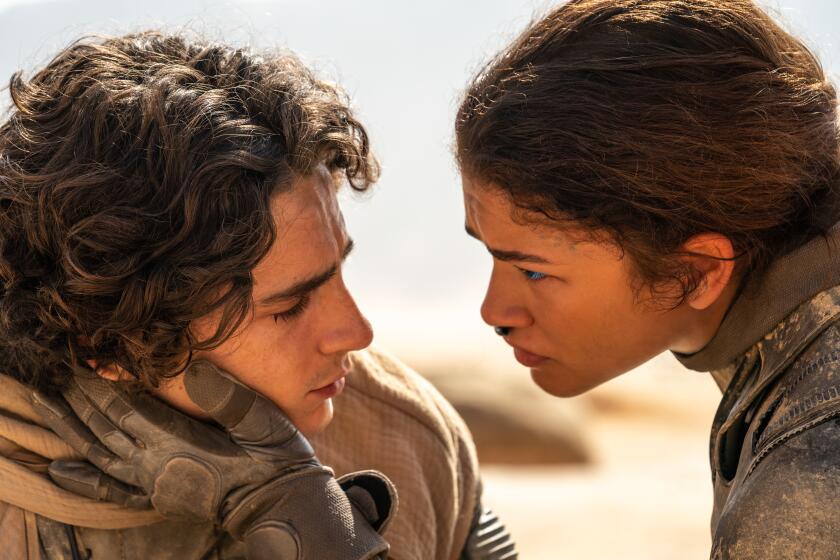A tough year — and tough film themes — bring beauty by way of the music
- Share via
Plenty of adjectives come to mind when describing 2020, but two top thoughts would be “fractured” and “isolated.” It’s only fitting, then, that some of the year’s best film scores — and the stories they accompany — bear those qualities.
Whether it’s the fracturing of a soul from its corporeal body, or the broken bones and isolation of a drunk screenwriter coming up with a cinematic masterpiece; whether it’s the men and women and countries that were shattered by the Vietnam War; or whether it’s the pieces of a woman on an island of grief after the death of her baby — the great movie music of 2020 reflected back the pain of loneliness and disintegration felt so keenly off the screen.

Howard Shore
‘Pieces of a Woman’
Director Kornél Mundruczó has a background in opera and theater, and he wanted an overtly classical approach to the score for his wrenching film “Pieces of a Woman” — starring Vanessa Kirby as Martha — which opens with an unbroken half-hour sequence of a home birth that ends in tragedy and then spends the remainder sifting through the broken pieces.
Mundruczó turned to Howard Shore, the elder statesman behind “The Lord of the Rings” and “The Silence of the Lambs,” whose 2010 piano concerto “Ruin and Memory” — written for Lang Lang to celebrate the 200th birthday of Chopin — served as a starting point. Shore repurposed elements from that concert work for the film, and he gave the entire score a concerto feeling, with lonely, virtuosic solos assigned to piano, oboe and cello.
Shore wrote two main themes: one for Martha’s grief — a melody often expressed on piano — and one for the baby, who is seen only briefly. “It’s a way to keep the idea of the baby, the loss of the child, in the film,” he said.
In one scene, Martha rides a bus and looks around at all of the children playing and happily talking to their parents. Shore underlined the moment with a statement of the baby theme on the lullaby-like celeste, adding subtext to Kirby’s nonverbal performance.
“It’s all expressions on her face,” he said. “It’s a very interior scene, even though she’s on a crowded bus. But everything is on her face. It’s very emotional.”
Shore’s overall role, he felt, was to provide a sense of warmth against the bleakness and despair that hangs over the whole story. “I think I’m providing a bit of optimism where I can,” he said. “There’s a lot of beauty in it, and hope.”
In a final scene, as Martha begins piecing her life together, Shore introduces a new melodic idea that was partly improvised by pianist Holger Groschopp. “I was able to just take the notes off the page,” Shore said, “and create something that had more resolution, more freedom to it.”
Trent Reznor and Atticus Ross
‘Soul’ / ‘Mank’
The Oscar-winning composers of “The Social Network” — who once upon a time were better known as the brooding rockers of Nine Inch Nails — pushed themselves in two wildly new directions in 2020. The schedules for “Soul” and “Mank” may have overlapped, but the music by Trent Reznor and Atticus Ross did anything but.
For the Pixar film “Soul,” the duo had to prove that optimism was in their toolbox. While the film was still in development several years ago, they wrote a batch of tracks because, Reznor said, “we wanted to make sure we could give them comfort to know: Hey, we can make music that isn’t just, you know, bowel-churning stuff to feel uncomfortable about.”
The Reznor-Ross score — a pulsing, kinetic light show for synthesizers and a digitally processed concoction of cello, Reznor’s voice and other acoustic ingredients — accompanies the film’s otherworldly planes. It’s juxtaposed against the jazzy music of Joe’s (Jamie Foxx) life on Earth, represented by Jon Batiste’s original contributions.
But the two musical streams converge in a special moment, when Joe sits down at the piano and plays a piece (performed by Batiste) that encapsulates the little moments that made his life meaningful. It was the moment Docter was most nervous about when he hired the Nine Inch Nails guys.
“I knew they would come up with new flavors for us,” said Docter. “But the stuff that we were a little less sure of was: Would they be able to deliver that sort of tender, vulnerable stuff?”
When he heard that piece (“Epiphany”) for the first time, Docter said, “I just started weeping, because it felt so much of what we were trying to say — that sort of sorrow and bittersweet, but beautiful and grateful. How do you express that in music? I have no idea. But they did.”
“Mank,” the duo’s fourth collaboration with David Fincher, is a surprising blend of solo piano, big-band music and mysterious orchestral score in the spirit of “Citizen Kane” composer Bernard Herrmann.
Known for movies about crime and chaos, director David Fincher delivers a personal tale with “Mank.”
Journeying into a completely unfamiliar stylistic and emotional mode, Reznor and Ross spent a lot of time imbibing music of the era, then created an hour of material to prove to Fincher — and themselves — that they could do it.
“Once we crossed that threshold of fearful, fearful, fearful,” said Ross, “then it was, ‘Oh, I’m actually really enjoying it, and I think this music sounds great.’ Sent it to David, and we get back a text, all capitals: ‘I WANT TO USE IT ALL.’”
“We slept well that night,” Reznor deadpanned.
Terence Blanchard
‘Da 5 Bloods’
Jazz virtuoso and veteran film composer Terence Blanchard finally landed his first Oscar nomination in 2019 for “BlacKkKlansman,” his 23rd project with Spike Lee. So he knows something about overdue recognition for a lifetime of excellence.
That was a feeling he wanted to convey in Lee’s “Da 5 Bloods,” which opens with a grand sequence of combat in the Vietnam War, with Chadwick Boseman leading his other “Bloods,” including Delroy Lindo and Clarke Peters.
“I had to tackle that, because I knew that that scene was going to inform the rest of the movie,” said Blanchard, who spent five days working on the scene.
“The music had to establish the grandeur of what it was they were doing and also the majesty of being a professional soldier. I hate using those terms, but I have to, because those guys ... they’re doing their jobs. And a lot of times, African Americans were doing their jobs under duress, because they weren’t really being celebrated back at home.”
As with so many of his films with Lee, Blanchard’s score is a fiery alloy of tragedy, contemporary anger — Lindo’s character suffers from PTSD and wears a MAGA hat — and operatic beauty. The latter is something he took away from his last war film with Lee.
The composer was excited to “do all of my Stravinsky-esque type stuff for this battle” in Lee’s 2008 movie “Miracle at St. Anna,” Blanchard remembered. “And Spike goes, ‘No, no, no, man — I want it to be more operatic. I want people to be able to sing something through this.’ And I knew that going into ‘Da 5 Bloods,’ so I had to figure out a way of having that very strong melodic content but the pulse and the power of what it meant to be a soldier.”
For the Vietnamese character Tiên Luu (Y. Lan), Blanchard wrote a mournful melody for duduk, an Armenian double reed woodwind, performed by Pedro Eustache.
“A lot of times we want to vilify the enemy,” Blanchard said. “But I’ve been to those countries as a musician, and when you go to those places, you find people that are just like you. Their traditions are different, obviously. Their customs are different, their food is different. But at life’s core exist human beings who want to be loved and recognized and want to feel safe, which is the same thing we all want. And that’s what that theme means to me.”
More to Read
From the Oscars to the Emmys.
Get the Envelope newsletter for exclusive awards season coverage, behind-the-scenes stories from the Envelope podcast and columnist Glenn Whipp’s must-read analysis.
You may occasionally receive promotional content from the Los Angeles Times.










